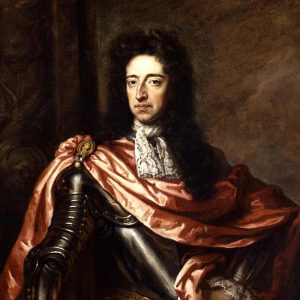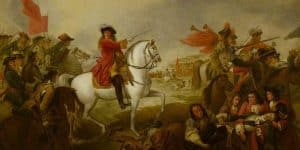The Battle of The Boyne
On 1 July 1690, two armies faced each other across the River Boyne, just to the north of Dublin in Ireland.
The commander on the north side was William of Orange, a dutch protestant, who had recently been crowned King of England, Scotland and Ireland.
The commander on the south side was James II, the deposed Catholic King, who had lost his throne to William only the year before.
The two men were linked by blood and family ties. James II was both the uncle of William of Orange and his father-in-law.
In 1688, William was invited to seize James II’s throne by Protestant nobles who feared James was founding a Catholic royal dynasty. James, who chose not to oppose him, was captured and then allowed to escape to exile in France.
King James II arrives in Ireland
In March 1689, James landed in Ireland with troops supplied by the Catholic King Louis XIV of France. France was the greatest military power in Europe at the time and Louis was William’s sworn enemy.
James saw Ireland as the back door through which he could invade England and regain his crown. Predominantly Catholic Ireland readily rallied to the ‘Jacobite’ (from the Latin for James) cause.
William of Orange arrives in Ireland

William of Orange
Throughout his reign, William’s focus was always firmly on his fight to bring to an end Louis XIV’s domination of Europe.
The crowns of England, Scotland and Ireland were vital to his ongoing struggle. James’ army represented a significant threat that William had to deal with decisively.
William’s invasion force was the largest Ireland had ever seen. Altogether he had more than one thousand horses to draw his artillery and gun equipment.
An eye-witness recalled Belfast Lough (the body of water connecting Belfast to the sea) looking like a wood:
“There is no less than seven hundred sail of ships in it, mostly laden with provisions and ammunition.
The great numbers of coaches, wagons, baggage horses and the like is almost incredible to be supplied from England, or any of the biggest nations in Europe. I cannot think that any army of Christendom hath the like.”
William himself stepped ashore at the northern port of Carrickfergus on 14 June 1690, where this pale asthmatic monarch, his face lined with the constant pain of fighting ill health, said in halting English that he had come to ensure the people of Ireland would be “settled in a lasting peace”.
The Pope backs William of Orange
William is celebrated to this day as a champion of Protestantism, but he was nonetheless backed by the head of the catholic church, Pope Alexander VIII. The Pope was part of a ‘Grand Alliance’ against Louis XIV’s warring in Europe and supported William’s reconquest of Ireland.
William’s army
William’s army reflected his leadership of the ‘Grand Alliance’. The core consisted of Dutch, Danish, Germans and Huguenots (French protestants persecuted by Louis XIV). His English troops were mainly raw recruits, reinforced by Ulster protestant ‘skirmishers’. These were described by the army chaplain George Story as being “half-naked with sabre and pistols hanging from their belts, as a horde of Tartars”.
James’ army
While most of William’s men were professional, well-paid, well-armed and recently fed, James’ Irish infantrymen were often armed only with scythes and farm tools. But their morale was high and – thanks to Louis XIV – they had some of the best cavalry in Europe.
The Boyne
The River Boyne lies 30 miles north of Dublin. It was the last natural barrier facing William as he marched south towards the city and James’ stronghold. James chose to make a stand at the Boyne, enshrining it as the location where, for the last time, two crowned kings of England, Scotland and Ireland would meet in battle.
William crosses the Boyne

The Battle of The Boyne
William was known for his sometimes reckless courage and the Boyne was no different.
He decided to investigate the river’s crossing points for himself and was shot at by Jacobite officers.
It was rumoured that William was dead, but a bullet had only grazed his shoulder.
He shrugged it off, reputedly saying: “Ce boulet est venu bien pres. Ce n’est rien” (“The ball came close enough, but it’s nothing”).
At almost 40 years of age, William was a battle-hardened commander and a veteran of countless campaigns. By contrast James, once praised for gallantry in battle as a younger man, was in his late fifties with his best years as a military leader behind him.
After four hours of fierce fighting, a significant body of William’s men had made it across to the Boyne’s southern riverbank. James’ cavalry had them pinned down, but they held and James gave the order to retreat.
A rout was avoided by Louis XIV’s cavalry skillfully covering the withdrawal.
Aftermath
Despite his army retreating in good order, James quickly abandoned them and returned to exile in France. William marched into Dublin and finally secured his reconquest of Ireland with the Treaty of Limerick in 1691.
William’s victory ended James II’s hope of regaining his throne. William was now securely in control of England, Scotland and Ireland, which would ultimately help him to reverse Louis XIV’s military conquests in Europe.
William ruled jointly with his wife Mary (James II’s daughter). Their reign marked an important transition from the direct rule of monarchs like James towards a more parliamentary system.
In Ireland, William’s victory dashed Jacobite hopes of recovering property that had been confiscated from Irish landowners since the days of Oliver Cromwell.
But for protestants, it secured their ascendancy in Ireland. In Ulster, it ensured the survival of the protestant, English-speaking colonies known as the Plantation. The victory is still celebrated every 12 July in Northern Ireland by the Orange Order, named for William of Orange.
Why the 12th of July?
The Battle of the Boyne was fought on 1 July 1690, according to the old Julian calendar. This was reformed and replaced with the Gregorian calendar across the British Empire in 1752, re-positioning the ‘date’ of the Battle of the Boyne to 11 July. The method of altering historical dates was somewhat complicated, with eleven days being added to ‘old style’ dates occurring after 1700, but only ten days to those taking place before that.
There is some dispute over whether celebrating on 12 July is simply the result of a slight historical miscalculation, or a case of the Battle of the Boyne replacing the Battle of Aughrim (another important battle in the Williamite War which took place on 12 July in the Julian calendar) as the focus of commemoration.
Either way, William’s victory at the Battle of the Boyne has been celebrated on 12 July for over 200 years.

